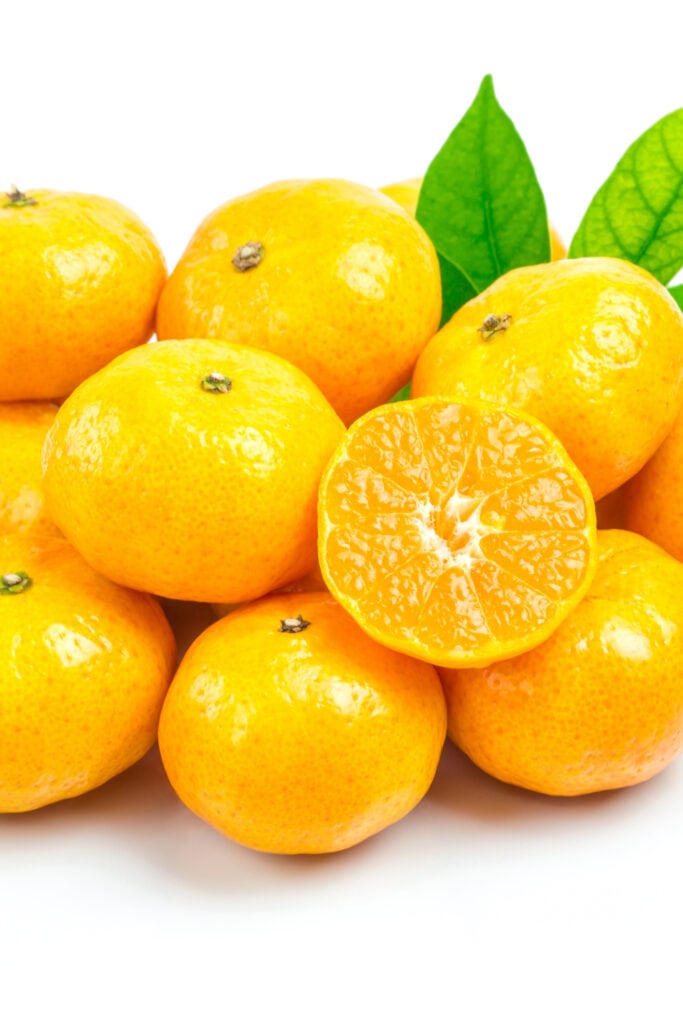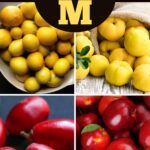Believe it or not, there are 30 fruits that start with M!
No doubt you’ve had melon and mango and mandarins. But have you ever tried a mora de castilla? What about a maqui?
At first, I thought I would struggle with this list.
But once I got going, I couldn’t believe how many vibrant, sweet, unusual, and delicious fruits there are out there! I should’ve known better!
Some of the fruits on this list will be familiar favorites, and you just might discover something new and exciting.
How many have you tried?

1. Mango
Mangoes are at the top of my list because they’re my favorite.
This bright, sweet fruit stole my heart a long time ago, and not just because it’s rich in fiber, vitamins, and antioxidants.
Also known as the “king of fruits,” mangoes are stone fruits with more than 500 different varieties.
They can be eaten raw and are fantastic when incorporated into desserts.
If you’re a mango-lover like me, check out these yummy mango recipes for some inspiration!

2. Macadamia Nuts
Did you know that most nuts are technically fruits?
That includes almonds, cashews, Brazil nuts, walnuts, pecans, and, of course, macadamia nuts.
Macadamia nuts have a lovely buttery flavor and a rich creaminess.
They’re also a great source of vitamins, fiber, healthy fats, and antioxidants.
There are so many fantastic macadamia nut recipes out there, but these white chocolate macadamia nut cookies are my favorite!
I like them thick and chewy with nice big chunks of white chocolate.

3. Mandarin
Mandarins are small citrus fruits in the orange family.
They’re smaller, sweeter, and a little easier to peel than their parent fruit, and great for snacking.
Clementines and tangerines are both different types of mandarin, and they all are very similar in size and taste.
Although, mandarins are often favored for being slightly sweeter and seedless.
I used to get mandarins in my Christmas stocking every year!

4. Maracuya
Maracuya is the Spanish word for passion fruit.
Native to Brazil and Argentina, these are typically yellow in color with a slight pineapple flavor to the flesh.
These have a milder flavor but are noticeably sweeter, but the inside of the fruit looks the same as normal passion fruit.

5. Melon
Melons are actually a kind of berry, with a sweet and tender flesh inside and usually quite a few seeds.
I’m sure you’ve tried watermelon, cantaloupe, honeydew, and maybe canary melon.
But did you know there are more than 38 different types of melon?
Next time you’re on vacation, keep an eye out for casaba, crenshaw, honey globe, and Santa Claus!

6. Mamoncillo
Though the Mamoncillo is known as a Spanish lime, it’s actually not a citrus fruit. Instead, it’s a close relative of the lychee.
They get their name thanks to the green coloring and the fact that they taste like a cross between a lychee and a lime.
The flesh is gelatinous inside the leathery skin, with a sweet, tangy flavor.
7. Madrono
Madronos are native to Europe and have a bumpy skin over a bitter flesh.
The tree is known as the “Irish strawberry tree” as the fruits can be pink, red, or even yellow.
The red berry has citrus notes, and the flesh looks similar to that of a lemon.
8. Masak Hijau Banana
This variety of banana has the tallest tree and is typically found in Malaysia.
The fruits can be anywhere from 15 to 25 cm (5.9 to 9.8 in) in length!
They taste much like normal bananas, but some people say they have a more pronounced flavor, making them great for cooking.

9. Madras Thorn/ Manila Tamarind
Manila Tamarind grows on trees in pods, and thick pulp inside has a sweet and acidic taste.
Loaded with vitamin C, this has been used as an antiseptic for years and for use on toothaches, mouth ulcers, and sore gums.

10. Manzana
Manzana is the Spanish word for apple. We all know the favorites – Granny Smith, Pink Lady, and Golden Delicious.
But the oldest known variety is the Annurca apple, coming from Southern Italy.
Apples have been a favorite snack for centuries, with their edible skin, bright colors, and sweet flesh.
I like mine crisp and sweet, but I know plenty of people that prefer something more sour.
If just the mention of the manzana has you drooling, check out these 30 easy apple recipes for some incredible treats!
11. Mora
Mora are a type of blackberry, that grows like a raspberry and has a lovely tangy and sweet taste.
Full of vitamins A, C, E, K and folic acid, it can be used just like you would blackberries – in smoothies, jams, or fruit salad.

12. Maqui
This little purple berry grows in the wild all over South America, and the leaves, stems, and berries have been used in medicines for quite some time.
With its sweet and refreshing flavor, it’s been used to treat everything from dry eye, diabetes, diarrhea, and fevers, to heart disease and fatigue.
13. Mammee Apple
Also known as a “South American apricot,” the mammee is quite complex for so small a fruit.
People have noted flavors of vanilla, honey, nutmeg, apricots, and root beer, along with pumpkin and sweet potato!
14. Merton Pride Pear
This English pear has a sweet, smooth, and very fruity tasting flesh.
It was first developed in the 1940s in Surrey as a cross between the Williams and the Glou Morceau pear varieties.
The skin turns from green to yellow and the creamy white fruit inside is known to be very juicy.
15. Melon Pear
Grown in South America, the pepino dulce – sweet cucumber – is an odd mix of a melon and a cucumber.
It often grows in an adorable heart shape, and should be eaten much like a melon – peel the skin and remove the seeds before eating the flesh.

16. Membrillo
Membrillo is the Spanish term for quince, which is kind of like a lumpy pear.
It tastes a lot like a cross between an apple, pear, and something citrusy.
In Spain, you’ll often see dulce de membrillo, a fruity paste used and served much like guava paste, with cheeses and dried fruits.
17. Madison Peach
Though most of our peaches hail from Georgia, the Madison peach is a hearty variety that can be grown even in colder climates.
The tree is robust and frost-resistant!
The fruit has a gorgeous red coloring and deep yellow, mild, and sweet flesh.

18. Miracle Fruit
This red berry is native to West Africa and is usually used for medicinal purposes.
It is also a well-known natural sweetener. In the 1960s, the FDA banned its use in the United States following pressure from the sugar industry.
19. Maqueno Banana/Plantain
Though they may look like bananas, plantains does not have that sweet, familiar flavor we all love.
Instead, they’re quite starchy, and savory, and are much better fried and served with roasted meats and spices.
20. Mora De Castilla
Here’s another wonderful type of blackberry that can be found all over Latin America and the Andes.
It is known to be very juicy with a much more pronounced flavor than regular raspberries or blackberries.
21. May Pride Peach
As the name might suggest, these sweet little peaches are known to be early bloomers.
These are available much earlier in the year, so if you want some peach cobbler in May, try to find some of these babies!

22. McIntosh Apple
Did you know that the McIntosh Apple is the national apple of Canada? I think it’s got to do with the bright red skin!
Usually available in late September, the flesh is sweet, but quite tart, and wonderfully crisp.
23. Macoun Apple
The variety of apple is a blend of the McIntosh and Jersey Black.
The coloring is slightly darker, almost like a plum, and the taste is distinctly sweet and juicy, with just a touch of berry.
These make a great baking alternative if you find some baking apples too tart.
24. Margil Apple
This is the oldest known dessert apple from England, though it is believed to have originated in France.
It is crisp and juicy and has a very “apple-like” flavor.

25. Mini-Mandarin Oranges
Did you know that women in China used to clasp mandarins in their hands so that they would smell like the sweet, citrusy fruit? Pretty clever, right?
Mini-mandarins are, simply put, smaller mandarins. They taste almost exactly the same.
These are excellent for small children to snack on, as they have no seeds and are mild yet sweet.
26. Marsh Pink Grapefruit
Coming from the marsh white grapefruit, this blushed version was seemingly grown by accident and found on a stray limb in Texas.
They have a milder, sweeter flavor than typical grapefruit, along with a lovely pink hue.

27. Mexican Limes
Also known as “Key limes,” these are more yellow than green and are a hybrid fruit hailing all the way from Southeast Asia.
They have a very sharp, sour, and almost bitter flavor to them.
This bitterness is what makes them perfect for baking – to help balance out the sweetness.
I’m a huge key lime pie lover, but this Trisha Yearwood Key lime cake is the next best thing.

28. Meyer Lemon
Another hybrid, the Meyer lemon was cultivated in China as a cross between a lemon and a mandarin.
The skin is smoother but still yellow, and they have a much sweeter flavor, with hints of orange throughout.
They tend to be more expensive but are worth it if you’re looking for something different.
29. Marisol Clementine
Here’s another variation on the sweet little orange!
Much like the parent fruit, this is a sweet little orange with a pleasant tartness. It is believed to have been cultivated in Egypt.

30. Muskmelon
A member of the gourd family, this sweet orange/yellow fruit is related to squash, pumpkin, zucchini rather than other fruits.
It looks much like honeydew or cantaloupe, but the skin is noticeably smoother, and it’s pretty sweet – though it can be bland if not eaten when ripe.












Don’t forget the humble medlar!